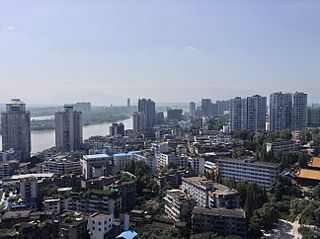Nestled in Sichuan province, Leshan is renowned for hosting the largest and tallest stone Buddha statue in the world – the Leshan Giant Buddha. Carved into the cliffs of Mount Lingyun overlooking the confluence of three rivers, this colossal 71-meter tall sculpture dates back to the 8th century. Leshan offers a captivating insight into China’s rich cultural heritage, nestled among green-clad hills, rivers, and ancient temples. It is a treasure trove of spiritual solemnity and natural beauty, appealing to both history buffs and nature enthusiasts.
Be sure to visit during the early morning or late afternoon to avoid the crowds and experience a more tranquil view of the Giant Buddha.
Consider taking a boat tour for a different perspective on the Giant Buddha and to fully appreciate the size and craftsmanship of this historical monument.
Top things to do & see in Leshan
Select the following sights and activities to discover best tickets and tours available in Leshan.
Leshan: The City of the Grand Buddha
| Country | China |
| Time in Leshan | GMT+8 |
| Language spoken | Mandarin |
| Population | 3,235,000 (as per the latest census data) |
| Currency | Renminbi (RMB ¥) |
| Airports |
|
Leshan, in Sichuan Province of China, is a city renowned for its spectacular landscapes and rich historical heritage. It is most famously known for the Leshan Giant Buddha, a colossal statue carved out of a cliff face overlooking the confluence of three rivers. This remarkable statue is the largest stone Buddha in the world and has been a UNESCO World Heritage site since 1996, attracting millions of tourists annually.
The city’s history stretches back over two millennia, having been an important center for Buddhism in China. The area around Leshan is also noted for its scenic beauty, characterized by lush green mountains and clear rivers, which have inspired many poets and artists throughout the ages.
The economy of Leshan thrives on tourism, agriculture, and manufacturing. The region is particularly famous for its tea plantations and bamboo forests. Culturally, Leshan offers a vivid snapshot of traditional Sichuan life, with its spicy cuisine, operatic arts, and vibrant festivals. Visitors to Leshan are treated not only to historical sites and natural beauty but also to a warm welcome from locals who are proud of their city’s heritage.
Where is Leshan?
Leshan is located in the southwestern part of Sichuan Province, China, at the confluence of the Dadu, Min, and Qingyi rivers.
Distances:
| Route | Distance by car | Time by car |
|---|---|---|
| From Chengdu to Leshan | 150 km | 2 hours |
| From Mianyang to Leshan | 245 km | 3.5 hours |
What is Leshan famous for?
Leshan is internationally famous for its Giant Buddha statue, imposingly carved into the riverside cliff face and standing an impressive 71 meters tall.
History
Ancient Leshan: Prior to 200 BCE
Before becoming the bustling city we know today, Leshan’s region was primarily populated by ancient tribes. Archaeological findings suggest that these early inhabitants were settled along the fertile banks of the Min and Dadu Rivers, fishing and farming in these rich and abundant waters, laying the foundation for future development.
Founding of Leshan: 200 BCE – Tang Dynasty (618-907 AD)
The city of Leshan was officially founded during the Qin Dynasty after the unification of China under Emperor Qin Shi Huang. It initially served as a strategic location along the southern Silk Road. However, its significance grew during the Tang Dynasty when Buddhism spread throughout China, leading to the construction of the grand Leshan Giant Buddha, carved into the cliff face overlooking the confluence of three major rivers.
Song Dynasty to Qing Dynasty: 960-1912 AD
During the Song and subsequent dynasties, Leshan’s role as a commercial and spiritual hub continued to flourish. Trade, both domestic and along the Silk Road, contributed to its wealth and diversity. The city saw further development in arts, culture, and education during these centuries, attracting scholars, monks, and traders.
Modern Era: 1912 to Present
Entering the modern era, Leshan continued to thrive through turbulent times, including the fall of the Qing Dynasty, the Republican era, and the rise of modern China. Its historical relevance, coupled with natural beauty, transformed Leshan into a significant tourist destination. Its heritage and traditions, reflected throughout the city, continue to draw visitors and scholars alike. Today, Leshan balances its rich historical heritage with modern advancements, retaining its status as a cultural and historical icon in China.
Visit Leshan
What to see and do in Leshan
Visiting Leshan offers a journey through history, spirituality, and natural beauty. The must-visit site is the iconic Leshan Giant Buddha, the largest stone Buddha in the world and a UNESCO World Heritage Site. This colossal statue is carved directly into the mountainside, overlooking the convergence of the Minjiang, Dadu, and Qingyi rivers. Nearby, the Oriental Buddha Park features thousands of Buddhist statues and carvings that review the artistry of different dynasties.
- Explore Wuyou Temple, offering serene views and rich historical artifacts.
- Visit Leshan’s old city to enjoy local cuisine and traditional Sichuan opera.
- Trek up to Lingyun Mountain for a panoramic view of the city and rivers.
Annual Events in Leshan
Leshan hosts several annual events that reflect its cultural heritage and communal spirit. Notably, the Leshan Giant Buddha International Tourism Festival happens every autumn, celebrating the city’s history and attractions with performances, parades, and local cuisine showcases, drawing visitors from across the globe.
Best time to visit Leshan
The optimal time to visit Leshan is in spring (April to June) and autumn (September to November). These seasons offer mild weather, making it comfortable for exploring the outdoor attractions and the grandeur of the Leshan Giant Buddha without the harsh summer heat or the chilly winter air.
Is Leshan worth visiting?
Leshan is undoubtedly worth visiting for those who appreciate cultural richness and historical depth. The Leshan Giant Buddha alone is a marvel of human ingenuity and devotion. However, visitors should be prepared for crowds, especially during peak tourist seasons and festivals. While its allure is undeniable, the experience can be affected by the number of tourists and weather conditions. Nevertheless, with careful planning, Leshan offers an enriching experience that blends spiritual heritage with breathtaking natural scenery.









